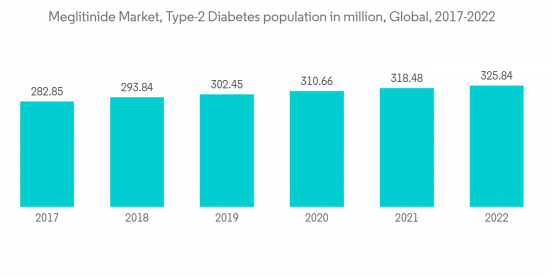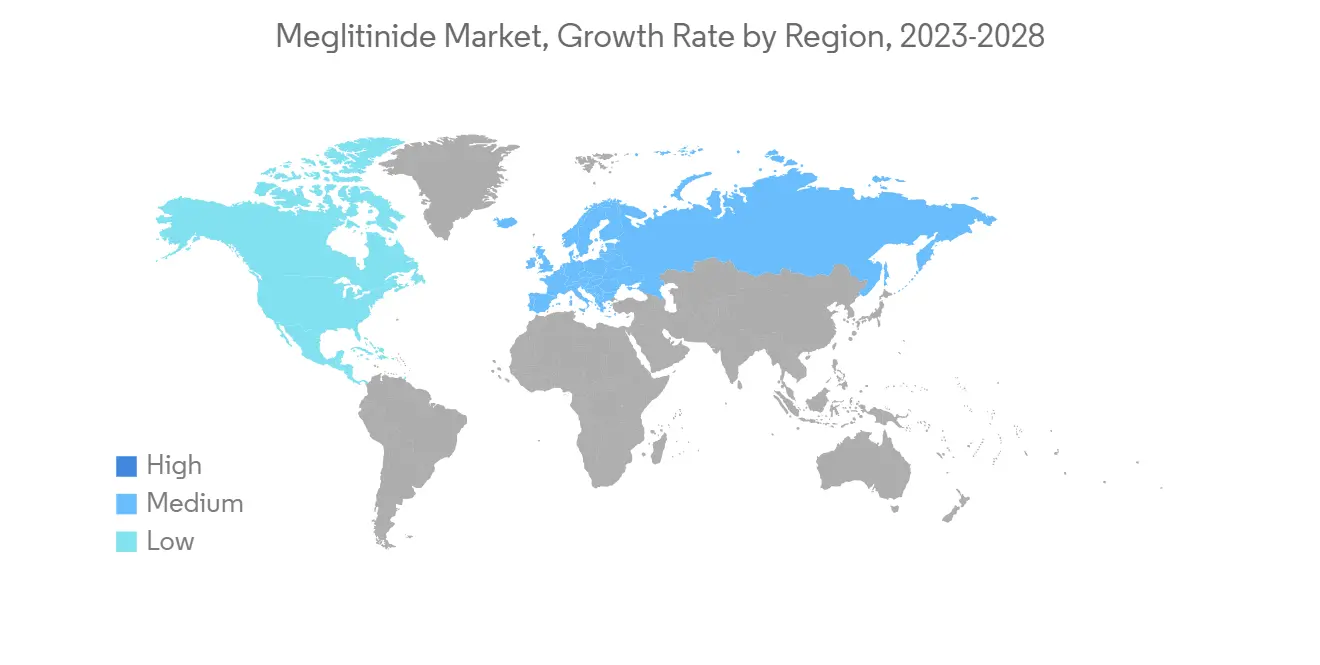
|
市場調査レポート
商品コード
1332490
メグリチニド市場規模・シェア分析- 成長動向と予測(2023年~2028年)Meglitinide Market Size & Share Analysis - Growth Trends & Forecasts (2023 - 2028) |
||||||
カスタマイズ可能
適宜更新あり
|
|||||||
| メグリチニド市場規模・シェア分析- 成長動向と予測(2023年~2028年) |
|
出版日: 2023年08月08日
発行: Mordor Intelligence
ページ情報: 英文 80 Pages
納期: 2~3営業日
|
- 全表示
- 概要
- 目次
メグリチニド市場規模は2023年に41億5,000万米ドルと推定され、2028年には46億3,000万米ドルに達すると予測され、予測期間中(2023~2028年)のCAGRは2.21%で成長する見込みです。
2027年には45億米ドル以上に達すると推定されます。
COVID-19の流行はメグリチニド市場に大きな影響を与えています。COVID-19感染で入院した人々に糖尿病が蔓延し、血糖コントロールの改善がSARS-CoV-2患者の転帰を改善し、入院期間を短縮する可能性が認識されたことで、抗糖尿病薬市場の重要性が強調されました。糖尿病患者は免疫系が弱く、COVID-19合併症が病状を悪化させ、免疫系は急速に弱くなります。糖尿病とコントロールされていない高血糖は、COVID-19患者の予後を悪くする危険因子であり、重症化や死亡のリスクを高める。したがって、COVID-19の発生はメグリチニド市場の成長を世界的に増大させました。
メグリチニドは非スルホニルウレア系インスリン分泌促進薬の一種で、非常に速い作用発現と短い作用持続時間が特徴です。メグリチニドは、グルコース感受性で第一相インスリン分泌を刺激し、低血糖イベントのリスクを低減します。2型糖尿病患者は慢性的に血糖値が高く、メグリチニドは体内のインスリン分泌を促進します。
2021年5月、世界保健総会は糖尿病の予防と管理の強化に関する決議に合意しました。同決議では、糖尿病治療のための医薬品や健康食品へのアクセスを増加させること、糖尿病治療薬や健康食品の市場の透明性に関連する情報を共有するためのウェブベースのツールを確立することの実現可能性と潜在的価値を評価することなどの分野での行動を推奨しています。
国際糖尿病連合(IDF)によると、2021年の成人糖尿病人口は約5億3,700万人で、2030年には6億4,300万人増加します。新たに1型糖尿病と2型糖尿病と診断される患者の割合は、主に肥満、不健康な食事、運動不足が原因で増加すると見られています。糖尿病患者の発生率と有病率が急速に増加し、ヘルスケア支出が世界的に増加していることは、抗糖尿病薬の使用量が増加していることを示しています。技術的な進歩や技術革新は、薬剤や開発中の製剤にいくつかの改良を加えることにつながっています。
したがって、前述の要因によって、この市場は分析期間中に成長すると予想されます。
メグリチニド市場の動向
世界の糖尿病有病率の上昇
糖尿病人口は予測期間中に世界で1.92%増加すると予測されます。
IDFによると、2021年の成人糖尿病人口は約5億3,700万人で、2030年には6億4,300万人増加すると予測されています。新たに1型糖尿病と2型糖尿病と診断される患者の割合は、主に肥満、不健康な食生活、運動不足が原因で増加すると見られています。糖尿病予備軍も増加し、それがさらに2型糖尿病へと発展し、合併症、急性・長期合併症、死亡の危険因子を引き起こします。世界の糖尿病患者の増加とヘルスケア支出の増加は、糖尿病治療薬への傾斜が強まっていることを示しています。
2型糖尿病はますます蔓延しており、心血管疾患や腎疾患のリスク増大と関連しています。ライフスタイルの改善とともに、メグリチニドは2型糖尿病の管理に用いられる経口薬です。メグリチニドは、膵臓のβ細胞からのインスリン分泌を促進することによって血糖値を下げます。メグリチニドの作用は、β細胞が機能しているかどうかに依存します。したがって、メグリチニドは1型糖尿病の患者には効かないです。技術の進歩や革新は年々進み、薬剤や開発中の製剤にいくつかの改良が加えられています。
WHOは、糖尿病の予防とケアの持続的な改善を目指す世界のイニシアチブであるGlobal Diabetes Compactを立ち上げ、特に中低所得国の支援に重点を置いています。同コンパクトは、各国政府、国連機関、非政府組織、民間セクター、学術機関、慈善財団、糖尿病患者、国際的な支援者を結集し、糖尿病のリスクを低減し、糖尿病と診断されたすべての人々が公平で包括的、かつ安価で質の高い治療とケアを受けられるようにするというビジョンを共有することを目的としています。
したがって、有病率の増加と前述の要因により、調査対象市場は分析期間中に成長を遂げると予想されます。

予測期間中、中東とアフリカがメグリチニド市場を独占する見込み
予測期間中、中東とアフリカがCAGR約4%で最も高い伸びを示すと予測されます。
メグリチニドはスルホニル尿素と同様の作用を示します。現在使用可能なメグリチニドはレパグリニドとナテグリニドの2種類です。レパグリニドとナテグリニドは2型糖尿病患者において単独または他の経口糖尿病薬との併用で承認されています。メグリチニドの主な作用は食後血糖値の低下であり、その結果HbA1cが低下します。メグリチニドは、膵β細胞からのインスリン分泌を増加させることによって機能します。
IDF 2021によると、2021年にはIDF MENA地域で7,300万人の成人が糖尿病を患っています。この数字は2030年までに9,500万人に増加すると推定されています。IDF MENA地域の4,800万人の成人は耐糖能障害を抱えており、2型糖尿病を発症するリスクが高いです。2021年、IDF MENA地域では796,000人が糖尿病により死亡しました。中東・アフリカ地域では、糖尿病の有病率が驚くほど増加しています。近年、糖尿病の罹患率は、主にライフスタイルの変化により、過去最高に達しています。糖尿病は多くの健康合併症を伴う。糖尿病患者は、血糖値をモニターしながらインスリンを追加投与したり、炭水化物を追加摂取するなど、正常な血糖値を維持するために、一日を通して多くの修正を必要とします。
政府は、糖尿病の結果をコントロールするための計画や政策に取り組んできました。例えば、サウジアラビア政府は2022年7月に、サウジアラビアでは人口の増加と高齢化、糖尿病や肥満などの生活習慣病の有病率の増加などの変化により、質の高いヘルスケアサービスに対する需要が高まっていると発表しました。政府と民間セクターはともに、ヘルスケア事業体、認証、規制に取り組んでいます。政府は、サウジアラビア国民の100%を保険でカバーするための措置を講じており、手頃な価格、アクセス、質の高いデジタルヘルスケアとプライマリケアを費用対効果で確保するために取り組んでいます。
前述の要因により、市場は予測期間中に成長すると見込まれています。

メグリチニド産業の概要
メグリチニド市場は断片化されており、Novo Nordisk、Glenmark、Novartisなどのメーカーが世界市場で存在感を示しており、ジェネリック医薬品メーカーの存在により市場競争は激しいです。
その他の特典
- エクセル形式の市場予測(ME)シート
- 3ヶ月間のアナリスト・サポート
目次
第1章 イントロダクション
- 調査の前提条件と市場定義
- 調査範囲
第2章 調査手法
第3章 エグゼクティブサマリー
第4章 市場力学
- 市場概要
- 市場促進要因
- 市場抑制要因
- ポーターのファイブフォース分析
- 供給企業の交渉力
- 消費者の交渉力
- 新規参入業者の脅威
- 代替品の脅威
- 競争企業間の敵対関係の強さ
第5章 市場セグメンテーション
- 薬剤
- メグリチニド
- 地域
- 北米
- 米国
- カナダ
- 北米以外
- 欧州
- ドイツ
- スペイン
- イタリア
- フランス
- 英国
- ロシア
- その他欧州
- アジア太平洋
- 日本
- 中国
- オーストラリア
- インド
- 韓国
- マレーシア
- インドネシア
- タイ
- ベトナム
- フィリピン
- その他アジア太平洋地域
- ラテンアメリカ
- ブラジル
- メキシコ
- その他ラテンアメリカ
- 中東・アフリカ
- 南アフリカ
- サウジアラビア
- オマーン
- エジプト
- イラン
- その他中東とアフリカ
- 北米
第6章 市場指標
- 1型糖尿病人口
- 2型糖尿病人口
第7章 競合情勢
- 企業プロファイル
- Biocon
- Boehringer Ingelheim
- Bristol Myers Squibb
- Glenmark
- Kissei Pharmaceuticals
- Mylan
- Novartis
- Novo Nordisk
- Pfizer
- Teva Pharmaceuticals
- 市場シェア分析
- Boehringer Ingelheim
- Novartis
- Novo Nordisk
- その他の市場シェア分析
第8章 市場機会と今後の動向
The Meglitinide Market size is estimated at USD 4.15 billion in 2023, and is expected to reach USD 4.63 billion by 2028, growing at a CAGR of 2.21% during the forecast period (2023-2028).
The market is estimated to reach a value of more than USD 4.5 billion by 2027.
The COVID-19 pandemic has had a substantial impact on the Meglitinide market. The prevalence of diabetes in people hospitalized with COVID-19 infection and the recognition that improved glycemic control might improve outcomes and reduce the length of stay in patients with SARS-CoV-2 have underlined the importance of the anti-diabetic drugs market. People with diabetes have a weaker immune system, the COVID-19 complication aggravates the condition, and the immune system gets weaker very fast. Diabetes and uncontrolled hyperglycemia are risk factors for poor outcomes in patients with COVID-19 including an increased risk of severe illness or death. Thus, the COVID-19 outbreak increased the meglitinide market's growth globally.
Meglitinides are a class of non-sulfonylurea insulin secretagogues characterized by very rapid onset and shorter duration of action. They stimulate first-phase insulin release in a glucose-sensitive manner, reducing the risk of hypoglycemic events. People with type 2 diabetes have chronically high blood sugar levels and meglitinides make the body free up more insulin.
In May 2021, the World Health Assembly agreed on a Resolution on strengthening the prevention and control of diabetes. It recommends action in areas including increasing access to medicines and health products for the treatment of diabetes and assessing the feasibility and potential value of establishing a web-based tool to share information relevant to the transparency of markets for diabetes medicines and health products.
According to International Diabetes Federation (IDF), the adult diabetes population in 2021 is approximately 537 million, and this number is going to increase by 643 million in 2030. The rate of newly diagnosed Type 1 and Type 2 diabetes cases is seen to increase, mainly due to obesity, unhealthy diet, and physical inactivity. The rapidly increasing incidence and prevalence of diabetic patients and healthcare expenditure worldwide are indications of the increasing usage of anti-diabetic drugs. Technological advancements and innovations have increased over the period leading to several modifications either in the drugs or the formulations being developed.
Therefore, owing to the aforementioned factors the studied market is anticipated to witness growth over the analysis period.
Meglitinide Market Trends
Rising diabetes prevalence globally
The diabetes population is expected to rise by 1.92% globally over the forecast period.
According to the IDF, the adult diabetes population in 2021 was approximately 537 million, and this number is expected to increase by 643 million in 2030. The rate of newly diagnosed type-1 and type-2 diabetes cases is seen to increase, mainly due to obesity, an unhealthy diet, and physical inactivity. Increased numbers of people are at increased risk of prediabetes, which can further lead to type-2, causing risk factors for complications, acute and long-term complications, and deaths. The increased prevalence of diabetic patients and healthcare expenditure worldwide are indications of an increased inclination toward diabetic drugs.
Type-2 diabetes is increasingly prevalent and associated with an increased risk for cardiovascular and renal disease. Along with lifestyle changes, meglitinides are oral medications used in the management of type-2 diabetes. They work by lowering blood glucose levels by stimulating insulin release from the beta cells of the pancreas. Their action is dependent upon the presence of functioning beta cells; therefore, meglitinides do not work in people with type-1 diabetes. Technological advancements and innovations have increased over the years, leading to several modifications either in the drugs or the formulations being developed.
WHO launched the Global Diabetes Compact, a global initiative aiming for sustained improvements in diabetes prevention and care, with a particular focus on supporting low and middle-income countries. The Compact is bringing together national governments, UN organizations, nongovernmental organizations, private sector entities, academic institutions, philanthropic foundations, people living with diabetes, and international donors to work on a shared vision of reducing the risk of diabetes and ensuring that all people who are diagnosed with diabetes have access to equitable, comprehensive, affordable, and quality treatment and care.
Therefore, due to increased prevalence and the aforementioned factors, the studied market is anticipated to witness growth over the analysis period.

Middle East and Africa are expected to dominate the Meglitinides Market over the forecast period
Over the forecast period, the Middle East and Africa are expected to register the highest CAGR of about 4%.
Meglitinides act in a similar manner to sulfonylureas. There are currently two meglitinides available: repaglinide and nateglinide. Both are approved for use alone and in combination with other oral diabetes drugs in people with type-2 diabetes. The major effect of meglitinides is the reduction of after-meal blood glucose levels, which results in a reduction in HbA1c. They function by increasing insulin secretion from pancreatic beta cells.
According to IDF 2021, 73 million adults were living with diabetes in the IDF MENA Region in 2021. This figure is estimated to increase to 95 million by 2030. 48 million adults in the IDF MENA Region live with impaired glucose tolerance, which places them at increased risk of developing type-2 diabetes. Diabetes was responsible for 796,000 deaths in the IDF MENA region in 2021. The Middle East and African regions have witnessed an alarming increase in the prevalence of diabetes. In recent years, the rate of diabetes has reached an all-time high, mainly due to lifestyle changes. Diabetes is associated with many health complications. Patients with diabetes require many corrections throughout the day to maintain normal blood glucose levels, such as administering additional insulin or ingesting additional carbohydrates by monitoring their blood glucose levels.
The government has been working on plans and policies to control the outcome of diabetes. For instance, the Saudi government announced in July 2022 that Saudi Arabia saw growing demand for quality healthcare services spurred by changes including an increasing and aging population and a growing prevalence of lifestyle diseases such as diabetes and obesity. The government and private sector are both involved in working on healthcare entities, certifications, and regulations. The government is taking steps to have 100 percent of Saudi citizens covered by insurance and is working towards ensuring affordability, access, and quality digital healthcare and primary care with cost-effectiveness.
Owing to the aforementioned factors, the market is expected to grow during the forecast period.

Meglitinide Industry Overview
The meglitinide market is fragmented, with manufacturers like Novo Nordisk, Glenmark, and Novartis etc. having a global market presence and the market is highly competitive due to generic drugs manufacturers' presence.
Additional Benefits:
- The market estimate (ME) sheet in Excel format
- 3 months of analyst support
TABLE OF CONTENTS
1 INTRODUCTION
- 1.1 Study Assumptions and Market Definition
- 1.2 Scope of the Study
2 RESEARCH METHODOLOGY
3 EXECUTIVE SUMMARY
4 MARKET DYNAMICS
- 4.1 Market Overview
- 4.2 Market Drivers
- 4.3 Market Restraints
- 4.4 Porter's Five Forces Analysis
- 4.4.1 Bargaining Power of Suppliers
- 4.4.2 Bargaining Power of Consumers
- 4.4.3 Threat of New Entrants
- 4.4.4 Threat of Substitute Products and Services
- 4.4.5 Intensity of Competitive Rivalry
5 MARKET SEGMENTATION
- 5.1 Drug
- 5.1.1 Meglitinide
- 5.2 Geography
- 5.2.1 North America
- 5.2.1.1 United States
- 5.2.1.2 Canada
- 5.2.1.3 Rest of North America
- 5.2.2 Europe
- 5.2.2.1 Germany
- 5.2.2.2 Spain
- 5.2.2.3 Italy
- 5.2.2.4 France
- 5.2.2.5 United Kingdom
- 5.2.2.6 Russia
- 5.2.2.7 Rest of Europe
- 5.2.3 Asia-Pacific
- 5.2.3.1 Japan
- 5.2.3.2 China
- 5.2.3.3 Australia
- 5.2.3.4 India
- 5.2.3.5 South Korea
- 5.2.3.6 Malaysia
- 5.2.3.7 Indonesia
- 5.2.3.8 Thailand
- 5.2.3.9 Vietnam
- 5.2.3.10 Philippines
- 5.2.3.11 Rest of Asia-Pacific
- 5.2.4 Latin America
- 5.2.4.1 Brazil
- 5.2.4.2 Mexico
- 5.2.4.3 Rest of Latin America
- 5.2.5 Middle East and Africa
- 5.2.5.1 South Africa
- 5.2.5.2 Saudi Arabia
- 5.2.5.3 Oman
- 5.2.5.4 Egypt
- 5.2.5.5 Iran
- 5.2.5.6 Rest of Middle East and Africa
- 5.2.1 North America
6 MARKET INDICATORS
- 6.1 Type-1 Diabetes Population
- 6.2 Type-2 Diabetes Population
7 COMPETITIVE LANDSCAPE
- 7.1 COMPANY PROFILES
- 7.1.1 Biocon
- 7.1.2 Boehringer Ingelheim
- 7.1.3 Bristol Myers Squibb
- 7.1.4 Glenmark
- 7.1.5 Kissei Pharmaceuticals
- 7.1.6 Mylan
- 7.1.7 Novartis
- 7.1.8 Novo Nordisk
- 7.1.9 Pfizer
- 7.1.10 Teva Pharmaceuticals
- 7.2 MARKET SHARE ANALYSIS
- 7.2.1 Boehringer Ingelheim
- 7.2.2 Novartis
- 7.2.3 Novo Nordisk
- 7.2.4 Other Market Share Analyses


